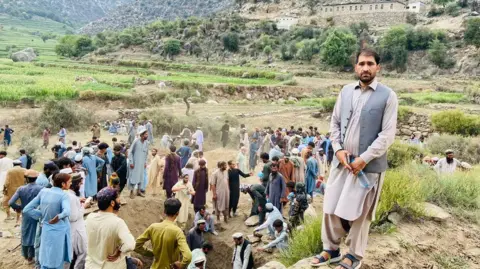Just before midnight on Sunday, Matiullah Shahab awoke to find his house in Afghanistan's remote Kunar province shaking. An earthquake measuring 6.0 magnitude had struck eastern Afghanistan, leaving at least 800 people dead, according to the UN.
Even though the epicenter was 16km away, the whole of Shahab's village of Asadabad trembled. The 23 family members living with him fled their bedrooms in fear. We were all afraid, he recalls.
The quake primarily affected the Nangarhar and Kunar provinces, with tremors felt as far away as Kabul and neighboring Islamabad.
The next day, Shahab, a freelance journalist and human rights activist, journeyed to the mountainous region near the epicenter, walking for two hours due to road blockages. In the village of Andarlachak, he witnessed a tragic scene with young children receiving treatment in the streets and many bodies covered in white sheets. I saw many dead bodies, Shahab described.
Rescue efforts have been hampered by blocked roads, leading to reliance on helicopters for reaching remote villages. Volunteers are trying to help trapped individuals, with reports of women rescued from collapsed homes.
Community members, shocked and grieving, are in dire need of shelter due to widespread destruction, exacerbated by the Taliban's restrictions on media coverage and rescue operations. Ezzatullah Safi, another resident, likened the devastating experience to a small apocalypse, recalling screams and fear prevailing as people became isolated due to connectivity failures and damage to their homes.
The situation remains precarious, with many areas still inaccessible and the heavy toll of human loss evident in the faces of survivors struggling to make sense of the catastrophe they endured.
Even though the epicenter was 16km away, the whole of Shahab's village of Asadabad trembled. The 23 family members living with him fled their bedrooms in fear. We were all afraid, he recalls.
The quake primarily affected the Nangarhar and Kunar provinces, with tremors felt as far away as Kabul and neighboring Islamabad.
The next day, Shahab, a freelance journalist and human rights activist, journeyed to the mountainous region near the epicenter, walking for two hours due to road blockages. In the village of Andarlachak, he witnessed a tragic scene with young children receiving treatment in the streets and many bodies covered in white sheets. I saw many dead bodies, Shahab described.
Rescue efforts have been hampered by blocked roads, leading to reliance on helicopters for reaching remote villages. Volunteers are trying to help trapped individuals, with reports of women rescued from collapsed homes.
Community members, shocked and grieving, are in dire need of shelter due to widespread destruction, exacerbated by the Taliban's restrictions on media coverage and rescue operations. Ezzatullah Safi, another resident, likened the devastating experience to a small apocalypse, recalling screams and fear prevailing as people became isolated due to connectivity failures and damage to their homes.
The situation remains precarious, with many areas still inaccessible and the heavy toll of human loss evident in the faces of survivors struggling to make sense of the catastrophe they endured.





















